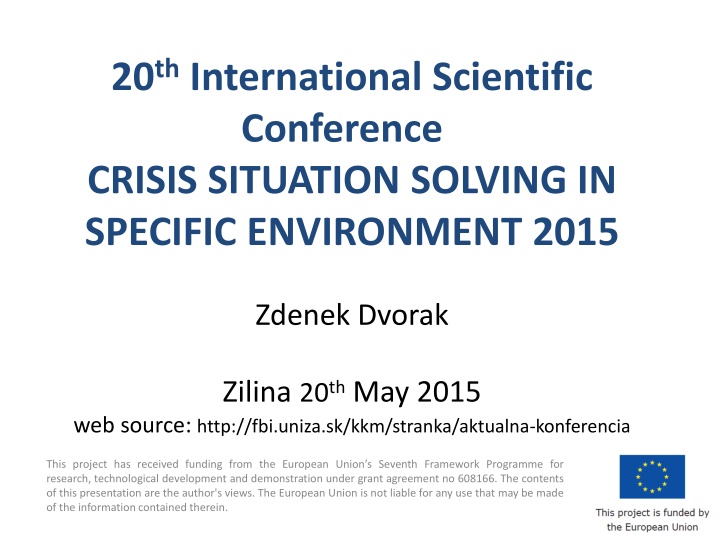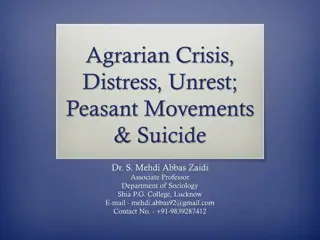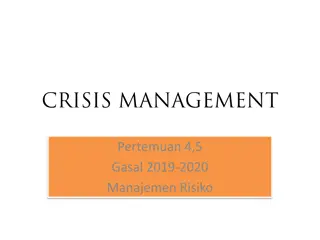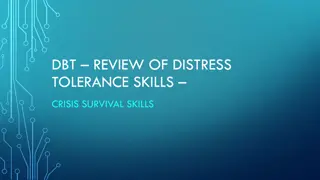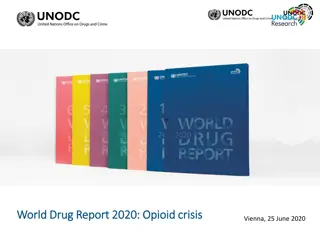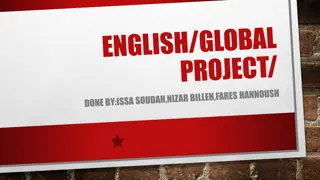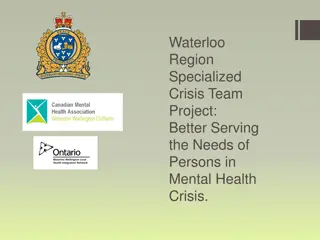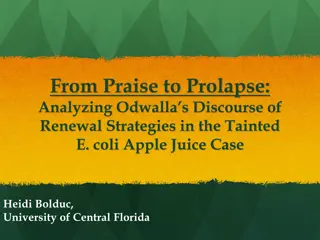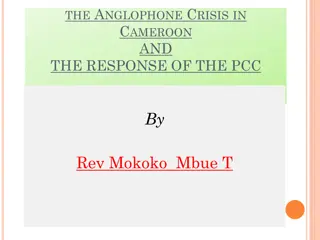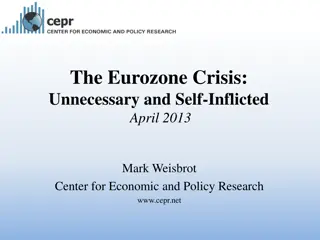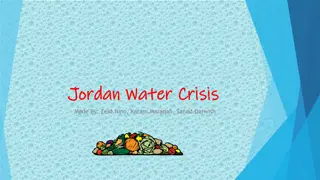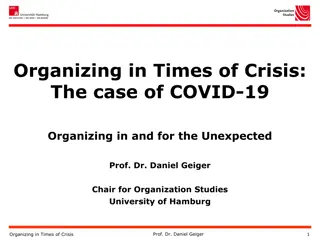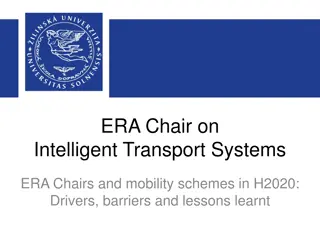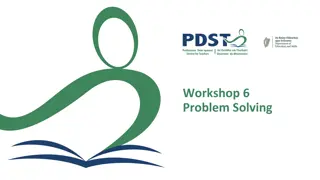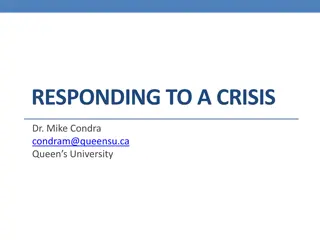Crisis Situation Solving in Specific Environment Conference 2015 Zilina
International Scientific Conference on Crisis Situation Solving in Specific Environment took place in Zilina on 20th May 2015. The event focused on the impacts of river floods on critical land transport infrastructure in North-West Slovakia. Various case studies and scenarios were presented, funded by the European Union Seventh Framework Programme.
Download Presentation

Please find below an Image/Link to download the presentation.
The content on the website is provided AS IS for your information and personal use only. It may not be sold, licensed, or shared on other websites without obtaining consent from the author.If you encounter any issues during the download, it is possible that the publisher has removed the file from their server.
You are allowed to download the files provided on this website for personal or commercial use, subject to the condition that they are used lawfully. All files are the property of their respective owners.
The content on the website is provided AS IS for your information and personal use only. It may not be sold, licensed, or shared on other websites without obtaining consent from the author.
E N D
Presentation Transcript
20thInternational Scientific Conference CRISIS SITUATION SOLVING IN SPECIFIC ENVIRONMENT 2015 Zdenek Dvorak Zilina 20thMay 2015 web source: http://fbi.uniza.sk/kkm/stranka/aktualna-konferencia This project has received funding from the European Union s Seventh Framework Programme for research, technological development and demonstration under grant agreement no 608166. The contents of this presentation are the author's views. The European Union is not liable for any use that may be made of the information contained therein.
Case study WP3 - Impacts of river floods on road and rail critical infrastructure in North - West Slovakia Zden k Dvo k University of ilina zdenek.dvorak@fbi.uniza.sk www.rain-project.eu SCSin SE Zilina 20-21 May 2015 This project has received funding from the European Union s Seventh Framework Programme for research, technological development and demonstration under grant agreement no 608166. The contents of this presentation are the author's views. The European Union is not liable for any use that may be made of the information contained therein.
Task 3.1: Identify and Review of Critical Land Transport Infrastructures failure (Case Studies NW Slovakia) 1. Describing specific case studies having destruction impacts on critical transport infrastructure. UNIZA will solve the impacts of river floods on road and rail critical infrastructure in North- West Slovakia (UNIZA Region) 2. D 3.3 Scenarios and case study of river floods on road and rail critical land transport infrastructures (M12) This project has received funding from the European Union s Seventh Framework Programme for research, technological development and demonstration under grant agreement no 608166. The contents of this presentation are the author's views. The European Union is not liable for any use that may be made of the information contained therein.
Task 3.1: Place and connection of case studies in RAIN This project has received funding from the European Union s Seventh Framework Programme for research, technological development and demonstration under grant agreement no 608166. The contents of this presentation are the author's views. The European Union is not liable for any use that may be made of the information contained therein.
Task 3.1: Participation on case study - NW Slovakia 1. Alan O Connor, Brian Caulfield, Maria Nogal (TCD) 2. Pieter Groenemeijer, Tom P ik (ESSL) 3. Timo Hellenberg (HI) 4. Chiara Bianchizza (ISIG) 5. M ria Luskov , Zden k Dvo k, Zden k Jadrn , Bohu Leitner (UNIZA) and Slovak partners: 1. ubom r Holl (Regional department Zilina) 2. Karol Chorv th, Tibot ii ka (Ministry of transport SR) This project has received funding from the European Union s Seventh Framework Programme for research, technological development and demonstration under grant agreement no 608166. The contents of this presentation are the author's views. The European Union is not liable for any use that may be made of the information contained therein.
Task 3.1: Methodology of case study - NW Slovakia 1. Study relevant international projects and books - all 2. Creating recommended content TCD, ISIG, HI, UNIZA 3. Developing methodology TCD, ISIG, HI, UNIZA, 4. Analyzing contemporary statue UNIZA, Slovak partners 5. Analyzing weather events in past ESSL, UNIZA 6. Recommendations and conclusions UNIZA, Slovak partners This project has received funding from the European Union s Seventh Framework Programme for research, technological development and demonstration under grant agreement no 608166. The contents of this presentation are the author's views. The European Union is not liable for any use that may be made of the information contained therein.
Task 3.1: Structure of case study - NW Slovakia 1. 2. 3. 4. 5. 6. 7. 8. Executive Summary Introduction Shortcuts and key terms Analyses of contemporary statue Analyses phase after the event scenario Conclusion References Appendix I Chosen objects
Ad 2. Case study - Introduction the background to the issue, the objective or purpose of the report, a definition of the research problem/topic, a definition of the report s terms of reference), an outline of the report s structure, an overview of the report s sections and their relationship to the research problem, an outline and justification of the scope of the report , a description of the range of sources used, acknowledgment of any valuable assistance received in the preparation of the report This project has received funding from the European Union s Seventh Framework Programme for research, technological development and demonstration under grant agreement no 608166. The contents of this presentation are the author's views. The European Union is not liable for any use that may be made of the information contained therein.
Ad 3. Case study - Shortcuts and key terms Key words: Critical infrastructure, Critical infrastructure element, Critical infrastructure sector, Sectoral criteria, Cross-cutting criteria,
Ad 4. Case study - Analyses of contemporary statue 4.1 General framework for civil protection System of civil protection and crisis management is base on law 42/1994 revised 2014. Training of local and regional civil protection bodies International cooperation 4.2 Historical, societal and legal aspects of the civil protection system Changes between civil protection before 1989 and after 1989 This project has received funding from the European Union s Seventh Framework Programme for research, technological development and demonstration under grant agreement no 608166. The contents of this presentation are the author's views. The European Union is not liable for any use that may be made of the information contained therein.
Ad 4. Case study - Analyses of contemporary statue 4.3 Description of meteorological event - ESSL Heavy Rainfall Windstorms Coastal Floods River Floods Landslides Lightning Tornadoes Hail Convective Windstorms Snowfall and Snow Storms Icing Snow Loading Forest Fires Freezing rain
Ad 4. Case study - Analyses of contemporary statue 4.3 Description of meteorological event - ESSL Analyze of real historical meteorological events Event analysis Lack of high-resolution satellite and radar data from this case preclude any detailed analysis of the thunderstorm development and progression (Sokol and Sokolova, personal communication). However, it seems that thunderstorm existed in a form of a slowly moving multicellular system with signs of backbuilding (i.e. new thunderstorm cells forming against the direction of prevailing flow). Analysis of Slovak Hydrometeorologic Institute (1998) also mentions the supercellular nature of the thunderstorm, which could be supported by the fact that besides the flash flood, also very large hail was observed by the local inhabitants (hen egg size).
Ad 4. Case study - Analyses of contemporary statue 4.4 Description of transport infrastructure before the event Multimodal corridors Trans - European Transport Network (TEN-T) 4.4.1 Railway infrastructure function and capacity Bridgdes and tunnels 4.4.2 Road infrastructure function and capacity Bridges and tunnels 4.4.3 Summary for road and rail transport Advantages and challenges 4.5. Description of management phase planning System of crisis planning This project has received funding from the European Union s Seventh Framework Programme for research, technological development and demonstration under grant agreement no 608166. The contents of this presentation are the author's views. The European Union is not liable for any use that may be made of the information contained therein.
Ad 5. Case study - Analyses phase after the event scenarion 5.1 Description of meteorological event - heavy rainfall and dam defect creating hypothetic extraordinary flood 5.2 Description of transport infrastructure after the event - flooding of rail and road network 5.2.1 Function/capacity - influence for region 5.2.2 Structural elements - municipality and recovery units 5.3 Description of management detailed description 5.4 Damage caused to people travelling on the transport route during the event 5.5 Management of emergency integrated emergency system 5.6 Recovery road and rail companies, building companies and inhabitants This project has received funding from the European Union s Seventh Framework Programme for research, technological development and demonstration under grant agreement no 608166. The contents of this presentation are the author's views. The European Union is not liable for any use that may be made of the information contained therein.
Conclusion Recommendations and conclusions: 1. New and better infrastructure 2. Better communications between transport companies and municipalities 3. Actual crisis plans 4. Preparing electronic risks maps 5. Preparing fully automatic information system 6. . This project has received funding from the European Union s Seventh Framework Programme for research, technological development and demonstration under grant agreement no 608166. The contents of this presentation are the author's views. The European Union is not liable for any use that may be made of the information contained therein.
Conclusion Actual crisis plans Demonstration event Database Contacts Spaces Catalogue Sources Evidence Railway Risk Maps Crisis planning Threats Measures Documents
Conclusion - fully automatic information system KISKANMobile Mobile source No 1 Mobile source No 2 Mobile source No 3 IMAP Server Internet KISKAN Database SMTP Server Email server Server KISKAN Server KISKAN Windows Dispapching desk This project has received funding from the European Union s Seventh Framework Programme for research, technological development and demonstration under grant agreement no 608166. The contents of this presentation are the author's views. The European Union is not liable for any use that may be made of the information contained therein.
